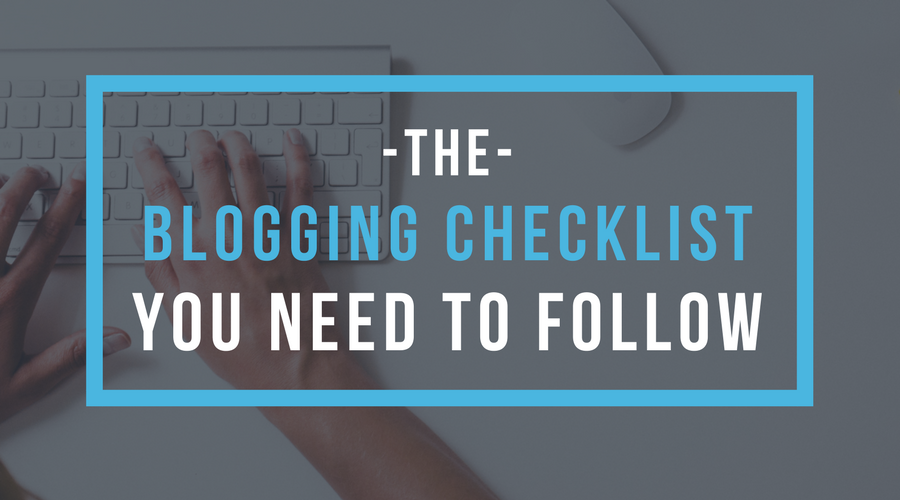
It’s been established that blogging is an essential tool for every inbound marketer. At Hüify, we have a blogging checklist that we follow each time we format a post. This can be used by anyone in any industry wanting to create awesome blog posts. We even have some special tips for those of you who are using HubSpot to publish content.
There are certain things you can do on your blog that help improve the UX, as well as best practices to ensure you get the most mileage out of your posts. Follow the steps outlined in this post to ensure you end up with kick ass content.
Post Title
Your blog post title will be the first thing people see, and is likely to determine if they will click on your post or not. It is important that the title be clear as to what the blog will be about, no one likes clickbait.
Here are a few quick guidelines to follow for the title:
- The title should be align with the subject of the post.
- Every word in the title should be capitalized (including articles like “the” and “of”).
- Make the title less than 70 characters, including spaces. Google cuts the 70th character off.
- Utilize keywords. Incorporating keywords in your titles improves your chances to rank for the article. Try to keep them towards the beginning so that they are noticed right away and will have no chance of getting cut off.
SEE ALSO: 4 Steps to Kickstart Your Blog Content
Featured Image
Every blog post must have a featured image. This will be the image that is seen on the blog home page, as well as what pulls in when the post is shared on the web and social networks. Having a custom made image for each blog post is a big differentiator in keeping the appearance of your blog original and professional. In the image, it’s always beneficial to have the title of the post be the main focal point, this will give people context to what they are clicking on.
For those of you using HubSpot, it’s important to use the following rules for creating your blog images in HubSpot’s editor tool:
- Full width images should be 900px in width or more, even if the width of the blog is only 600px (for example). Using this width will ensure that if the blog dimensions are changed in the future, they will still be the full width of the page as blog width does not tend to exceed this.
- For those who don’t use HubSpot, these guidelines should still suffice. Just be sure to check the width of your blog to make sure it does not exceed 900px.
- When uploading images to use in blog posts: be sure to rename the file after the blog post you used it in. Include a keyword if relevant to make it more searchable in your database.
- In the settings tab, select the image as the featured image.
- If you have a longer post, or something that would benefit from a visual representation, it’s always nice to break up the copy with an image or two.
- Be sure to update the alt text of any images you use to be reflective of the image.
SEE ALSO: Master The Perfect Social Media Image Size For Every Platform
Headers (H1, H2, H3 and H4 Tags)
Headers provide direction, break up the post, and guide the reader through the content. Similarly to selecting the title for a blog post, the headers within a blog need to accurately describe what the following section is about. You want readers to be able to skim the headers and get a good understanding of what they are about to read.
When using HubSpot, use the following guidelines to make sure your headers are formatted correctly:
- Add headers: Use the Style > Format > Header options to emphasize titled sections of your blog.
- Do not use H1 in the body of the post (the title is already header 1, and that is the only time it should be used on the page).
- H2 tags should be used as your primary subheader.
- H3 tags should be any additional headings needed under a primary subheader.
- H4 tags should only be used for SEE ALSOs.
Read More
Within the copy of the post, insert a “Read More” separator after the first paragraph or so. This is the text that will be previewed on the blog home page. If the Read More tab is not inserted before publishing, it will auto insert and display too much of the blog post.
CTA
A blog post without a CTA is like a dead end road. You’re lead down it, but there is nothing for you at the end. You want to take every available opportunity you have to convert readers. There should be one main CTA with an actionable tie-in description at the end of every post.
- There are two types of CTAs we use in blogs: in-line and bottom of the post.
- Do not use bottom CTAs in the middle of a post, as these are typically large, and should be reserved for the bottom of the post.
- Every post needs a CTA at the bottom. In-line CTAs are optional.
- Think about your CTA. Is this CTA meant for blog posts? Where does this link take them? Does it fit this content?
- After the body conclusion, neatly wrap up the blog post with a quick sentence to tie it to the CTA at the bottom.
- Appropriately source images (if they required sourcing) at the end using italicized 8 point font.
See Alsos
See alsos are another key opportunity for keeping your audience engaged, and keeping them on your site. We like to call them SEE ALSOs, but you may have seen them elsewhere written as Read More, MORE HERE, or something of the like.
- Include 2-3 of these in each blog posts.
- These should always be in H4 in HubSpot.
- Only link the article title, not the ‘SEE ALSO’ text.
- Always check the ‘Open in a new window’ box when linking.
- Be consistent. Whichever variation of 'see also' you choose, be sure to use that same variation on every post.
Linking
Linking within a blog post can be great for SEO results, as well as the user experience. Providing additional resources relevant to what the reader is looking for can keep them on your site for longer.
Follow these key steps when linking in a post:
- Have at least 3 internal links in each post. These links can go to other static pages, landing pages, or other blog posts.
- Keyword hyperlinking improves SEO and will help to rank in search.
- Don’t add hyperlinks to entire sentences.
- Make sure your hyperlinks make sense. Don’t link just anything and everything.
- When linking to an external site, ask yourself these questions beforehand:
- How does this outside source help the visitor convert on the client’s site?
- Will this link distract the visitor away from the client?
- How does this outside source improve the visitor’s experience?
- If linking to an outside source, make sure “open in a new window” is selected when linking.
- Linking to credible outside sources (i.e. Harvard Business Review, Forbes, etc.) builds credibility for a post in Google’s eyes.
Proofing
Proofing isn’t anything new. Every post that is published should be thoroughly proofread. Consult another content creator for long form pieces of content that require multiple revisions.
Blogging has potential to do great things for your business, especially if you take the time to follow great blogging practices. With this checklist, you should be able to get your blog on track for success in no time. Interested in learning more about inbound marketing and what it can offer your business? Click here to request a free inbound marketing plan.


 BACK TO ARTICLES
BACK TO ARTICLES 
.png)


